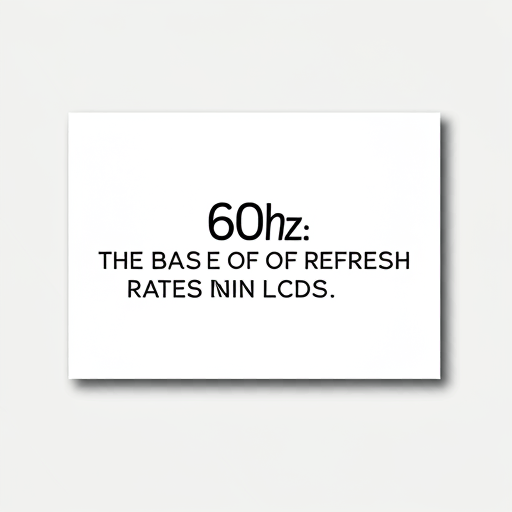Of all the specifications that will greatly influence both the performance and visual experience offered by LCD screens, refresh rate will perhaps be right at the top. Top 10 Refresh Rates in LCDs Measured in hertz, or Hz, it relates the number of times a display can update its image per second. Examples of such refresh rates are 60Hz, 120Hz, and powerful ones which reach 240Hz; it all depends on how much need there is. The such refresh rate may indeed give them good information concerning the consumers who may want to get some device for certain purposes.

Refresh Rate and Purpose of Refresh Rates in LCDs
Refresh rate is used to define smooth motion presented by the screen. For example, a 60Hz refresh rate refreshed its image 60 times within one second while the action was performed 120 times in a 120Hz display. This simply means that a display with a greater refresh rate will have smoother images especially during fast action items such as streams like sports broadcast, video games, or action movies.
Although these benefits are immediately apparent in gaming and high-speed video, higher refresh rates generally enhance viewing experiences. For example, scrolling through web pages or social media feeds might be an experience that is generally improved with a higher refresh rate-it simply makes the content feel smoother and more responsive.

60Hz: The Base of Refresh Rates in LCDs
Most ‘classic’ LCDs would run the standard refresh rate of 60Hz, especially with regards to TVs and budget monitors. 60Hz would basically be enough for general browsing, movie watching, and low-intensity gaming; however, for competitive gaming and high-octane video content and so on, the limits of 60Hz become rather apparent in Refresh Rates in LCDs.
Now, though 60Hz displays are quite good enough for daily purposes, they do lack a bit of smoothness when time comes to show the action fast. That is why one may notice motion blur or ghosting on such screens when frames are not updating at the same rate which the screen is meant to update. Casual users would still find this 60Hz screen pretty practical and economical for them.

120Hz: The Golden Mean of Refresh Rates in LCDs
If anything, the refresh rate of 120Hz has taken on the litmus test of interest-with considerable interest among gamers and high-end display models. Refresh Rates in LCDs However, it has improved enormously on visuals from 60Hz. Such high refresh rates reduce motion blur and translate to even much smoother visuals. For most gamers, the difference of lag and looking behind through a 120Hz display can be made.
Even more important, 120Hz was designed for the console industry, meaning loads of modern gaming consoles and PCs can issue 120Hz output, so the gamer can exploit every possibility of his hardware. Moreover, 120Hz is becoming increasingly frequent in high-end TVs. It is perfect for watching sports and action movies: smoother motion and reduced judder give a more immersive impression.
240Hz and Beyond the Refresh Rates in LCDs
Displays at 240Hz take the smoothness and fluidity a whole notch up for hardcore gamers and enthusiasts. In fast gaming scenes, when every millisecond counts, Refresh Rates in LCDs is quite helpful. At 240Hz refresh rates, ultra-smooth motion, lower input lag, and responsiveness come in Favor of the gamer. However, to have a 240Hz display work, so will the hardware plugged into it-most likely really powerful graphics cards and often gaming consoles.
While 240Hz screens are very nice, no one has to get them. Casual gamers or general media might find very subtle differences between 120Hz and 240Hz. So, Refresh Rates in LCDs is a question of weighing their specific needs against the cost of high-refresh-rate displays.
Conclusion
Refresh rates of LCDs: Comparison between the frequencies While being an important consideration point, refresh rates are also at times a competitive point for LCDs having different display features. A 60Hz refresh rate would be sufficient when doing routine chores, but in games, or with high-speed media, 120Hz is quite fluid by comparison. For the serious gamer who pushes things to an extreme, 240Hz will likely be the end game, as it will be quite likely the ultimate fluidity associated with such a display.
It will eventually become a personal preference with your usage of the device and budget, but as technology advances, the role of the refresh rate is going to start playing a more significant part in purchasing decisions, slowly changing the way you visually consume your digital content on every device.
FAQS
What is meant by refresh rate ?
The term refresh rate refers to how many times per second your monitor can display a new image, which is measured in hertz (Hz). One hertz equates to one new image per second. Therefore, a 120 Hz gaming monitor can potentially display 120 images every second.19-Oct-2022.
Pingback: Best 10 LCD Screen Sizes